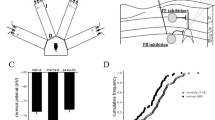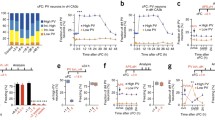Abstract
Pyramidal neurons in the piriform cortex of olfactory discrimination trained rats show enhanced intrinsic neuronal excitability that lasts for several days after learning. Such enhanced intrinsic excitability is mediated by long-term reduction in the postburst after hyperpolarization which is generated by repetitive spike firing. The molecular machinery underlying such long-lasting modulation of intrinsic excitability, as well as its exceptional durability, is yet to be fully described. In this review, we present recent advancements that reveal the identity of the current that is modulated after learning and the second messenger system by which enhanced excitability is maintained. We also discuss the significance of such long-lasting modulation to the local network’s sensitivity to noradrenaline, a major learning-relevant neuromodulator.






Similar content being viewed by others
References
Moyer JR, Thompson LT, Disterhoft JF (1996) Trace eyeblink conditioning increases CA1 excitability in a transient and learning specific manner. J Neurosci 16:5536–5546
Thompson LT, Moyer JR, Disterhoft JF (1996) Transient changes in excitability of Rabbit CA3 neurons with a time course appropriate to support memory consolidation. J Neurophysiol 76:1836–1849
Oh MM, Kuo AG, Wu WW, Sametsky EA, Disterhoft JF (2003) Watermaze learning enhances excitability of CA1 pyramidal neurons. J Neurophysiol 90(4):2171–2179
Saar D, Grossman Y, Barkai E (1998) Reduced after-hyperpolarization in rat piriform cortex pyramidal neurons is associated with increased learning capability during operant conditioning. Eur J Neurosci 10:1518–1523
Saar D, Grossman Y, Barkai E (2001) Long lasting cholinergic modulation underlies rule learning in rats. J Neuorsci 21(4):1385–1392
Saar D, Barkai E (2003) Long-term modifications in intrinsic neuronal properties and rule learning in rats. Eur J Neurosci 17:2727–2734
Schreurs BG, Gusev PA, Tomsic D, Alkon DL, Shi T (1998) ntracellular correlates of acquisition and long-term memory of classical conditioning in Purkinje cell dendrites in slices of rabbit cerebellar lobule HVI. J Neurosci 18(14):5498–5507
Alkon DL, Nelson TJ, Zhao W, Cavallaro S (1998) Time domains of neuronal Ca2+ signaling and associative memory: steps through a calexcitin, ryanodine receptor, K+ channel cascade. TINS 21(12):529–537
Zelcer I, Cohen H, Richter-Levin G, Lebiosn T, Grossberger T, Barkai E (2006) A cellular correlate of learning-induced metaplasticity in the hippocampus. Cerebral Cortex 16(4):460–468
Schwindt PC, Spain WJ, Foehring RC, Chubb MC, Crill WE (1988) Slow conductances in neurons from cat sensorimotor cortex in-vitro and their role in slow excitability changes. J Neurophysiol 59(2):450–467
Madison DV, Nicoll RA (1984) Voltage clamp analysis of cholinergic action in the hippocampus. J Physiol 354:319–331
Constanti A, Sim JA (1987) Calcium-dependent potassium conductance in guinea-pig olfactory cortex neurons in vitro. J Physiol 387:173–194
Barkai E, Hasselmo ME (1994) Modulation of the input/output function of rat piriform cortex pyramidal cells. J Neurophysiol 72(2):644–658
Moyer JR, Power JM, Thompson LT, Disterhoft JF (2000) Increased excitability of aged rabbit CA1 neurons after trace eyeblink conditioning. J Neurosci 20(14):5476–5482
Sah P, Bekkers JM (1996) Apical dendritic location of slow afterhyperpolarization current in hippocampal pyramidal neurons: implications for the integration of long-term potentiation. J Neurosci 16(15):4537–4542
Norris CM, Halpain S, Foster TC (1998) Reversal of age-related alterations in synaptic plasticity by blockade of L-type channels. J Neurosci 18(9):3171–3179
Barkai E, Saar D (2001) Cellular correlates of olfactory learning in the rat piriform cortex. Rev Neurosci 12(2):111–120
Saar D, Grossman Y, Barkai E (1999) Reduced synaptic facilitation between pyramidal neurons in the piriform cortex after odor learning. J Neurosci 19(19):8616–8622
Knafo S, Grossman Y, Barkai E, Benshalom G (2001) Increased spine density on piriform cortex pyramidal neurons after odor learning. Eur J Neurosci 13:633–638
Stackman RW, Hammond RS, Linardatos E, Gerlach A, Maylie J, Adelman JP, Tzounopoulos T (2002) Small conductance Ca2+-activated K+ channels modulate synaptic plasticity and memory encoding. J Neurosci 22(23):10163–10171
Storm JF (1989) An after-hyperpolarization of medium duration in rat hippocampal pyramidal cells. J Physiol 409:171–190
Sah P (1996) Ca2+-activated K+ currents in neurons: types, physiological roles and modulation. Trends Neurosci 19(4):150–154
Gasparini S, DiFrancesco D (1999) Action of serotonin on the hyperpolarization-activated cation current (Ih) in rat CA1 hippocampal neurons. Eur J Neurosci 11:3093–3100
Stocker M, Krause M, Pedarzani P (1999) An apamin-sensitive Ca+-activated k+ current in hippocampal pyramidal neurons. Proc Natl Acad Sci U S A 96:4662–4667
Sanchez-Andres JV, Alkon DL (1991) Voltage-clamp analysis of the effects of classical conditioning on the hippocampus. J Neurophysiol 65:796–807
Power JM, Wu WW, Sametsky E, Oh MM, Disterhoft JF (2002) Age-related enhancement of the slow outward calcium-activated potassium current in hippocampal CA1 pyramidal neurons in vitro. J Neurosci 22(16):7234–7243
Sah P, Faber ES (2002) Channels underlying neuronal calcium-activated potassium currents. Prog Neurobiol 66(5):345–353
Sailer CA, Hu H, Kaufmann WA, Trieb M, Schwarzer C, Storm JF, Knaus HG (2002) Regional differences in distribution and functional expression of small-conductance Ca2+-activated K+ channels in rat brain. J Neurosci 22(22):9698–9707
Brosh I, Rosenblum K, Barkai E (2006) Learning-induced reversal of the effect of noradrenalin on the postburst AHP. J Neurophysiol 96:1728–1733
Melyan Z, Wheal HV, Lancaster B (2002) Metabotropic-mediated kainate receptor regulation of IsAHP and excitability in pyramidal cells. Neuron 34(1):107–114
Melyan Z, Lancaster B, Wheal HV (2004) Metabotropic regulation of intrinsic excitability by synaptic activation of kainate receptors. J Neurosci 24(19):4530–4534
Seroussi Y, Brosh I, Barkai E (2002) Learning-induced reduction in post-burst after-hyperpolarization (AHP) is mediated by activation of PKC. Eur J Neurosci 16(5):965–969
Adams JP, Sweatt JD (2002) Molecular psychology: roles for the ERK MAP kinase cascade in memory. Annu Rev Pharmacol Toxicol 42:135–163
Atkins CM, Selcher JC, Petraitis JJ, Trzaskos JM, Sweatt JD (1998) The MAPK cascade is required for mammalian associative learning. Nat Neurosci 1:602–609
Schafe GE, Atkins CM, Swank MW, Bauer EP, Sweatt JD, LeDoux JE (2000) Activation of ERK/MAP kinase in the amygdala is required for memory consolidation of pavlovian fear conditioning. J Neurosci 20:8177–8187
Berman DE, Hazvi S, Rosenblum K, Seger R, Dudai Y (1998) Specific and differential activation of mitogen-activated protein kinase cascades by unfamiliar taste in the insular cortex of the behaving rat. J Neurosci 18:10037–10044
Blum S, Moore AN, Adams F, Dash PK (1999) A mitogen-activated protein kinase cascade in the CA1/CA2 subfield of the dorsal hippocampus is essential for long-term spatial memory. J Neurosci 19:3535–3544
English JD, Sweatt JD (1996) Activation of p42 mitogen-activated protein kinase in hippocampal long term potentiation. J Biol Chem 271(40):24329–24332
English JD, Sweatt JD (1997) A requirement for the mitogen-activated protein kinase cascade in hippocampal long term potentiation. J Biol Chem 272(31):19103–19106
Rosenblum K, Futter M, Jones M, Hulme EC, Bliss TV (2000) ERKI/II regulation by the muscarinic acetylcholine receptors in neurons. J Neurosci 20:977–985
Rosenblum K, Futter M, Voss K, Erent M, Skehel PA, French P, Obosi L, Jones MW, Bliss TV (2002) The role of extracellular regulated kinases I/II in late-phase long-term potentiation. J Neurosci 22:5432–5441
Thomas GM, Huganir RL (2004) MAPK cascade signalling and synaptic plasticity. Nat Rev Neurosci 5:173–183
Sheng M, Tsaur ML, Jan YN, Jan LY (1992) Subcellular segregation of two A-type K+ channel proteins in rat central neurons. Neuron 9:271–284
Yuan LL, Adams JP, Swank M, Sweatt JD, Johnston D (2002) Protein kinase modulation of dendritic K+ channels in hippocampus involves a mitogen-activated protein kinase pathway. J Neurosci 22:4860–4868
Cohen-Matsliah S, Brosh I, Rosenblum K, Barkai E (2007) A novel role for ERK in maintaining long-term memory-relevant excitability changes. J Neurosci 27:12584–12589
Gervais R, Pager J (1983) Olfactory bulb excitability selectively modified in behaving rats after local 6-hydroxydopamine treatment. Behav Brain Res 9(2):165–179
Przybyslawski J, Roullet P, Sara SJ (1999) Attenuation of emotional and nonemotional memories after their reactivation: role of beta adrenergic receptors. J Neurosci 19(15):6623–6628
Hasselmo ME, Linster C, Patil M, Ma D, Cekic M (1997) Noradrenergic suppression of synaptic transmission may influence cortical signal-to-noise ratio. J Neurophysiol 77(6):3326–3339
Sullivan RM, Wilson DA (1991) Neural correlates of conditioned odor avoidance in infant rats. Behav Neurosci 105:307–312
Sullivan RM, Wilson DA (1993) Role of the amygdala complex in early olfactory associative learning. Behav Neurosci 107:254–263
Sullivan RM, Wilson DA (1994) The locus-coeruleus, norepinephrine and memory in newborns. Brain Res Bull 35:467–472
Foehring RC, Schwindt PC, Crill WE (1989) Norepinephrine selectively reduces slow Ca- and Na-mediated K currents in cat neocortical neurons. J Neurophysiol 61(2):245–256
Barkai E, Bergman RE, Horwitz G, Hasselmo ME (1994) Modulation of associative memory function in a biophysical simulation of rat piriform cortex. J Neurophysiol 72(2):659–677
Quinlan E, Lebel D, Brosh I, Barkai E (2004) A molecular mechanism for stabilization of learning-induced synaptic modifications. Neuron 41:185–192
Hasselmo ME, Barkai E (1995) Cholinergic modulation of activity-dependent synaptic plasticity in the piriform cortex. J Neurosci 15(10):6592–6604
Author information
Authors and Affiliations
Corresponding author
Rights and permissions
About this article
Cite this article
Saar, D., Barkai, E. Long-Lasting Maintenance of Learning-Induced Enhanced Neuronal Excitability: Mechanisms and Functional Significance. Mol Neurobiol 39, 171–177 (2009). https://doi.org/10.1007/s12035-009-8060-5
Received:
Accepted:
Published:
Issue Date:
DOI: https://doi.org/10.1007/s12035-009-8060-5




